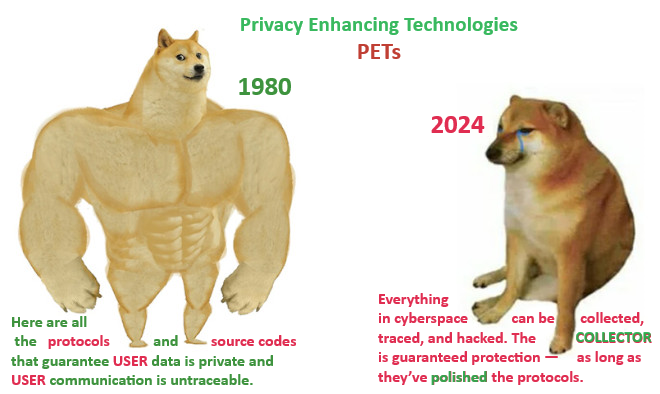The Silent Rebranding of Privacy-Enhancing Technologies: From Data Collection Prevention to Regulation

If you’ve ever wondered whether 'Privacy-Enhancing Technologies (PETs)' are as straightforward as they sound, you're not alone. The reality might surprise you. Dive in, and let’s explore what these technologies truly mean in today’s digital landscape. It’s time to get acquainted with your Cyber PETs!
In the early days of the digital revolution, privacy-enhancing technologies (PETs) emerged as a beacon of hope for those seeking to protect their personal information from the ever-encroaching eyes of surveillance. Spearheaded by pioneers like David Chaum from University California Berkeley (where we ourselves received one of our first experiences in advanced algebra), these technologies were designed with a singular purpose: to prevent the collection of data that could be used to track, profile, and ultimately control individuals.
Chaum’s work, particularly his 1981 paper on untraceable electronic mail, laid the foundation for a new era where individuals could communicate and interact in digital spaces without leaving a traceable footprint. This vision was rooted in the belief that an individual's right to control personal information throughout its journey in cyberspace was the cornerstone of preserving privacy in the digital age."
However, as these ideas shift permeated academic circles and entered the realm of public, policy a noticeable shift occurred. Governments and regulatory bodies began to see PETs not as tools to prevent data collection, but as mechanisms to manage and protect data after it had been collected. This evolution reflects a broader and perhaps more pragmatic approach to privacy in an increasingly data-driven world, where the focus has shifted from avoiding data collection thus to ensuring that once collected, data is handled responsibly and securely.
The Early Days: A Vision of Prevention
n the 1980s, as digital technologies began to reshape the landscape of communication and commerce, privacy advocates like Chaum envisioned a world where PETs could serve as a defensive shield against data collection. The core idea was that if data could not be collected, it could not be misused. This approach emphasized the importance of individual control over personal information, countering the growing surveillance capabilities of powerful actors with potentially ambiguous intentions.
The Shift: From Prevention to Management
By the mid-1990s, the European Union faced a rapidly evolving digital landscape. The 1995 Data Protection Directive was a strategic move by the EU Commission to regulate, rather than restrict, the growing practice of data collection, recognizing its significance for economic growth and governance. Instead of curbing data collection, as the mathematical techniques in Chaum's 1981 paper aimed to do by promoting complete anonymity and untraceability—concepts that anticipated technologies like Tor and blockchain—the Directive focused on ensuring that once collected, data was processed responsibly and securely, aligning with the EU’s broader economic objectives.
This marked a pivotal shift in the perception and application of privacy-enhancing technologies (PETs). The emphasis moved from preventing data collection to managing it in a way that minimized privacy risks. The concept of "privacy by design," popularized by Ann Cavoukian in the early 2000s, reinforced this approach. Rather than advocating for the cessation of data collection, Cavoukian’s framework embedded privacy considerations into the core architecture of data processing systems. This philosophy became a fundamental principle of the General Data Protection Regulation (GDPR) in 2018, which mandates the use of PETs to safeguard data post-collection, reflecting the EU’s focus on regulation over prohibition.
The Modern Landscape: Regulating Data Collection
Today, in its stripped-down and rebranded form, PETs have become integral to compliance with global data protection regulations. The GDPR’s "data protection by design and by default" principles require organizations to implement PETs that minimize data collection, anonymize personal information, and ensure the security of data throughout its lifecycle. While these measures are crucial, they represent a significant departure from the original vision of PETs as tools to prevent data c ollection altogether.
This evolution raises important questions about the future of cyber privacy in a world where data collection is not just inevitable but foundational to the goals of those who influence regulation. Is it enough to regulate how data is handled after it has been collected, or should we revisit the original intent of PETs to limit data collection at its source? As we continue to develop and implement new privacy technologies, this question will become increasingly critical.
Conclusion: A Call to Revisit the Foundational Vision
The transformation of PETs from tools of prevention to mechanisms of regulation reflects the complex interplay between technological innovation, regulatory frameworks, and societal values. While the modern application of PETs has undoubtedly strengthened data protection, it also underscores the need for a renewed focus on preventing unnecessary data collection in the first place.
As we navigate the future of privacy in the digital age, it is essential to strike a balance between the practicalities of data-driven innovation and the fundamental rights of individuals to control their personal information. Reinvigorating the original vision of PETs as a means to prevent data collection, rather than merely manage it, could be key to achieving this balance.
For further reading and a deep dive into the history and future of privacy-enhancing technologies, explore the works of David Chaum and the impact of the GDPR on global data protection standards here and here.